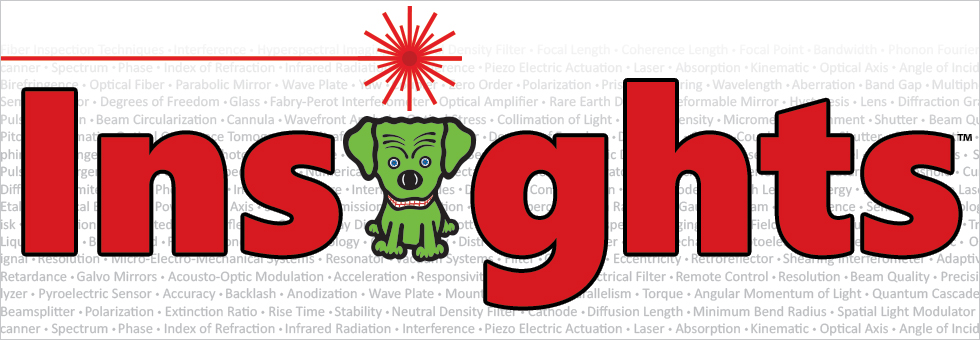実験・実習や機器に関するInsights-ヒント集


Please Wait
Insights:豆知識やヒントの共有
正しい情報を得られれば、何時間もの作業やフラストレーションを軽減することができます。しかしこのような貴重な知識の多くは、教科書には載ってなく、授業で教えられているものでもありません。またオンラインソースを検索しても簡単に見つけられるものでもありません。これらの知識の多くは経験から得られることが多く、フォトニクスの世界で働く人々の頭の中やラボノートの中にとどめられています。
当社ではこのような経験から得られたヒントや豆知識、ガイドライン、実践的なテクニックを集め、Insightsというヒント集にまとめました。現段階で集めたヒント集は下記のリンクや上のタブからご覧いただけます。こちらのページは随時更新して内容を拡充してまいります。
| (すべて見る) |
| (すべて見る) |
| (すべて見る) |
| (すべて見る) |
- テーブルクランプ:保持力を最大にする方法
- 光学テーブル:テーブルクランプとテーブル面の歪みについて
- ワッシャ:オプトメカニクスへの使用方法
- 電気信号: AC結合 vs DC結合
- ファイバーコリメータ:アダプタを使った取付け方法
- 移動ステージ中央の大きな取付け穴の使い方
- 直線ステージ取付けスロットの使い方
- 低パワー光の測定方法を改善する最初のステップ
| (すべて見る) |
| (すべて見る) |
| (すべて見る) |
- NAはファイバの受光角を表す指標となり得るか?
- MFDがシングルモードファイバにおいて重要な結合パラメータである理由とは?
- NAによりシングルモードファイバからのビーム広がり角がわかるか?
- シングルモードファイバへの光の結合効率に影響する因子は?
- 最大受光角はマルチモードファイバのコア全体に渡り一定か?
| (すべて見る) |
| (すべて見る) |
| (すべて見る) |
- レーザ装置からは、いつでもその筐体の軸に平行なコリメート光が放射されるか?
- 量子カスケードレーザ(QCL)とインターバンドカスケードレーザ(ICL):動作限界と発熱によるロールオーバ
- HeNeレーザ:取扱い方と取付け方のガイドライン
- チョッパーホイールを使用したビームサイズの測定法
- レーザ光に薄レンズの公式を適用できるか?
| (すべて見る) |
| (すべて見る) |
| (すべて見る) |
- なぜ球面ミラーではなく放物面ミラーを使うのか?
- 軸外放物面(OPA)ミラーの利点
- OAPミラーの軸外し角
- OAPミラーを使用したコリメート光の集光、および点光源からの光のコリメート
- OAPミラーの光軸と集光軸の特定方法
- OAPミラーをペアで使用すると像のリレーやビームへのアクセスが可能になります
- OAPミラーの取付けとアライメント
- OAPミラーをベースにした反射型コリメータにおける光の方向性
| (すべて見る) |
| (すべて見る) |
| (すべて見る) |
- 偏波保持ファイバはすべての入射光の偏光状態を維持するか?
- 偏波保持ファイバはどのようにして直線偏光を維持するのか?
- PANDA型およびボウタイ型偏波保持ファイバからの出射光の消光比(ER)を制限する要因
- ビート長とは?ビート長が偏波消光比の代わりに偏波保持ファイバの仕様として明記されている理由
- ストレスロッド(応力付与ロッド)タイプの偏波保持ファイバの温度依存性
| (すべて見る) |
- 垂直成分と平行成分の識別に使用されるラベルについて
- 偏光楕円と偏光状態の関係
- 偏光状態を表すのにポアンカレ球が役に立つ理由
- 非偏光の光源を使用して偏光素子の消光比を測定する方法
- 直線偏光の光源を使用して偏光素子の消光比を測定する方法
| (すべて見る) |
- レーザのビーム径に基づいてミラー径を選択するルールはあるか?
- ビームのアライメントはレトロリフレクタで反射されるビーム光路にどのように影響するか?
- レトロリフレクタープリズムの裏面を金属コーティングする理由は?
- コーナーキューブへの入射角は出射ビームのパワーに影響を及ぼすか?
| (すべて見る) |
| (すべて見る) |
- レーザのアライメント方法
- 精度を高めるための光パワーメーターパラメータの設定方法
- 手動ステージを電動ステージに変える方法
- ポストホルダを光学テーブル、ベース、ブレッドボードなどにボルトで固定するときの注意点
- 光アイソレータの調整方法
- 直線偏光子の軸をテーブルに対して垂直または平行にアライメントする方法
- ハンドヘルド型スクライブを使用して大きな直径の石英ファイバをクリーブする方法
- 光ファイバ用コンポーネントの挿入損失測定
- 1/4波長板を使用して円偏光に変換する方法
- 直線偏光子を入射面に対して45°にアライメントする方法
- <2本のシングルモードファイバ間に自由空間光を作るためのファイバーコリメータのアライメント方法
- TO-Can型半導体レーザのセットアップ(Viewer Inspired)
- ピグテール付、バタフライパッケージ型半導体レーザのセットアップ(Viewer Inspired)
- 1/4波長板のファスト軸とスロー軸を区別する方法
- Visual Studio®プロジェクト作成とC#プログラミング: Kinesis® BBD300シリーズコントローラを使用して
- 偏光計を構築して、ストークス値と偏光状態を特定する方法(Viewer Inspired)
- Visual Studio®とC#プログラミングによるラスタスキャン:Kinesis® BBD300シリーズコントローラを使用して
- 軸外放物面(OAP)ミラーをアライメントしてビームをコリメートする方法(Viewer Inspired)
- Visual Studio®とC#プログラミングによるカメラのセットアップと画像取得
- FiberBench上でのFiberPortのアライメント(Viewer Inspired)
- KF(QR)真空フランジの使い方
- ベース、ポストホルダ、ポストなどを取り付ける際の注意点
- レーザースペックルを利用してビームの焦点を見つける方法
- Python®Python®によるパワーメータと回転マウントの自動化(Viewer Inspired)
- 真空対応CF(コンフラット)フランジの使い方
- 空間光変調器(SLM)の位相遅延の校正方法(Viewer Inspired)
- シヤリングプレートコリメーションテスタを用いてレーザをコリメートする方法(Viewer Inspired)
- 偏波保持ファイバに結合する光の偏光方向をアライメントする方法(Viewer Inspired)
- ヘリオットセルのセットアップと構成(Viewer Inspired)
- LEDからの出力光をコリメートする方法
- 追尾機能を備えた太陽撮像望遠鏡の構築
| Posted Comments: | |
| No Comments Posted |
 Products Home
Products Home Insights-目次
Insights-目次